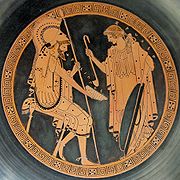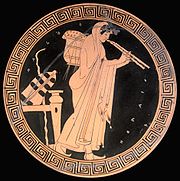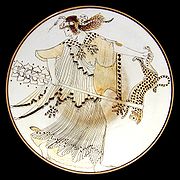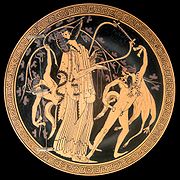
Brygos Painter
Encyclopedia


Ancient Greece
Ancient Greece is a civilization belonging to a period of Greek history that lasted from the Archaic period of the 8th to 6th centuries BC to the end of antiquity. Immediately following this period was the beginning of the Early Middle Ages and the Byzantine era. Included in Ancient Greece is the...
Attic
Attica
Attica is a historical region of Greece, containing Athens, the current capital of Greece. The historical region is centered on the Attic peninsula, which projects into the Aegean Sea...
red-figure
Red-figure pottery
Red-figure vase painting is one of the most important styles of figural Greek vase painting. It developed in Athens around 530 BC and remained in use until the late 3rd century BC. It replaced the previously dominant style of Black-figure vase painting within a few decades...
vase painter of the Late Archaic period. Together with Onesimos (vase painter)
Onesimos (vase painter)
Onesimos was an ancient Athenian vase painter who flourished between 505 and 480 BC. He specialized in decorating cups, mostly of Type B, which comprise virtually all known examples of his work....
, Douris
Douris (vase painter)
Douris was an ancient Athenian red-figure vase-painter and potter active ca. 500 to 460 BCE.-Work:He began his career painting for the potters Kleophrades and Euphronios, before beginning a long collaboration with the potter Python. He signed 39 vases as a painter, also one as a potter and...
and Makron
Makron (vase painter)
Makron was an ancient Greek vase painter active in Athens ca. 490-480 BC. Though only one signed example of his work is known to have survived, some 350 vases have been attributed to him by Sir John Beazley, making him one of the best surviving painters of the red-figure period.Makron is strongly...
, he is among the most important bowl painters of his time. He was active in the first third of the fifth century BCE, especially in the 480s and 470s. He was a prolific artist to whom over two hundred vases have been attributed, but he is perhaps best known for the Brygos Cup, a red-figure kylix in the Louvre
Louvre
The Musée du Louvre – in English, the Louvre Museum or simply the Louvre – is one of the world's largest museums, the most visited art museum in the world and a historic monument. A central landmark of Paris, it is located on the Right Bank of the Seine in the 1st arrondissement...
which depicts the "iliupersis" or sack of Troy.
The Brygos Painter's conventional name is derived from the potter Brygos
Brygos
Brygos was an ancient Greek potter, active in Athens between circa 490 and 470 BC. Brygos is known as a producer of excellent drinking cups. About 200 pieces by him are known. The workshop of Brygos employed a red-figure vase painter who is conventionally called the Brygos Painter...
who is known from signatures. The Brygos Painter appears to have painted the majority of bowls produced by Brygos. The name Brygos appears on several vases and cups of the late 6th century BCE and early 5th century BCE. It is not known whether the signature refers to the potter or painter or indeed whether the two roles were separate; by convention they are referred to as two distinct individuals.
He was one of the most productive painters of his generation; more than 200 vases have been attributed to him. Apart from bowls, he also paonted other vase shapes, such as skyphoi
Skyphos
In classifying the pottery of Ancient Greece, a skyphos is a two-handled deep wine-cup on a low flanged base or none. The handles may be horizontal ear-shaped thumbholds that project from the rim , or they may be loop handles at the rim or that stand away from the lower part of the body...
, kantharoi
Kantharos
A kantharos or cantharus is a type of Greek pottery used for drinking. It is characterized by its high swung handles which extend above the lip of the pot.The god Dionysus had a kantharos which was never empty....
, rhyta
Rhyton
A rhyton is a container from which fluids were intended to be drunk, or else poured in some ceremony such as libation. Rhytons were very common in ancient Persia, where they were called takuk...
, a kalathos-like vessel with a pouring spout and a number of lekythoi
Lekythos
A lekythos is a type of Greek pottery used for storing oil , especially olive oil. It has a narrow body and one handle attached to the neck of the vessel. The lekythos was used for anointing dead bodies of unmarried men and many lekythoi are found in tombs. The images on lekythoi were often...
. By far the majority of his works were bowls of the types B and C. The latter were often executed without maeander base lines, the former frequently stood on conical bases. The maeanders around his tondo
Tondo (art)
A tondo is a Renaissance term for a circular work of art, either a painting or a sculpture. The word derives from the Italian rotondo, "round." The term is usually not used in English for small round paintings, but only those over about 60 cm in diameter, thus excluding many round portrait...
paintings are rarely continuous, most are interrupted by sets or rows of crosses. Apart from his red-figure work, the Brygos Painter is known to have produced some white-ground
White Ground Technique
White-ground technique is a style of ancient Greek vase painting in which figures appear on a white background. It developed in the region of Attica.-Technique and style:...
vases.


Symposium
In ancient Greece, the symposium was a drinking party. Literary works that describe or take place at a symposium include two Socratic dialogues, Plato's Symposium and Xenophon's Symposium, as well as a number of Greek poems such as the elegies of Theognis of Megara...
and palaistra
Palaistra
Palaistra can refer to:*a palaestra*a place in the Greek prefecture of Florina...
scenes. Flat skulls, long noses and narrow eyes with rather high eyebrows ate characteristics of his style. His skill in painting the human mouth is remarkable: he can depict them as whistling, singing, playing the flute or clenching their lips with a high degree of anatomic accuracy. Stubbly beards or stubbly hair (on old men), as well as first signs of balding are also typical.
His mythical scenes are frequently original. Thus, he depicts the body of Ajax being covered by Tekmessa
Tecmessa
The name Tecmessa refers to the following characters in Greek mythology:*Tecmessa was the daughter of Teuthras, king of Teuthrania in Mysia, or Teleutas, king of Phrygia. During the Trojan War, Telamonian Ajax kills Tecmessa's father and takes her captive; his reason for doing so may have been, as...
, the handing-over of the body of Hector
Hector
In Greek mythology, Hectōr , or Hektōr, is a Trojan prince and the greatest fighter for Troy in the Trojan War. As the first-born son of King Priam and Queen Hecuba, a descendant of Dardanus, who lived under Mount Ida, and of Tros, the founder of Troy, he was a prince of the royal house and the...
and other scenes from the Trojan War
Trojan War
In Greek mythology, the Trojan War was waged against the city of Troy by the Achaeans after Paris of Troy took Helen from her husband Menelaus, the king of Sparta. The war is among the most important events in Greek mythology and was narrated in many works of Greek literature, including the Iliad...
. Dionysiac scenes are common as well. A famous bowl depicts satyr
Satyr
In Greek mythology, satyrs are a troop of male companions of Pan and Dionysus — "satyresses" were a late invention of poets — that roamed the woods and mountains. In myths they are often associated with pipe-playing....
s attacking the goddesses Iris
Iris (mythology)
In Greek mythology, Iris is the personification of the rainbow and messenger of the gods. As the sun unites Earth and heaven, Iris links the gods to humanity...
and Hera
Hera
Hera was the wife and one of three sisters of Zeus in the Olympian pantheon of Greek mythology and religion. Her chief function was as the goddess of women and marriage. Her counterpart in the religion of ancient Rome was Juno. The cow and the peacock were sacred to her...
. While Iris attempts to flee, hera is protected by Heracles
Heracles
Heracles ,born Alcaeus or Alcides , was a divine hero in Greek mythology, the son of Zeus and Alcmene, foster son of Amphitryon and great-grandson of Perseus...
and Hermes
Hermes
Hermes is the great messenger of the gods in Greek mythology and a guide to the Underworld. Hermes was born on Mount Kyllini in Arcadia. An Olympian god, he is also the patron of boundaries and of the travelers who cross them, of shepherds and cowherds, of the cunning of thieves, of orators and...
. Dionysos is present, but apparently uninvolved. As on many of the Brygos Painter's vases, the figures are named by inscription; at times he even describes what they say or call. In spite of his frequent use of writing, kalos inscriptions
Kalos inscription
The Kalos inscription was a form of epigraph found on Attic vases and graffiti in antiquity, common between 550 and 450 BC, and usually found on symposion vessels. The word καλός means "beautiful"; here it had an erotic connotation, and the inscription took the form of a youth's name, in the...
by the Brygos Painter are rare.
The Brygos Painter was associated with a broader circle of artists who were influenced by him or even worked with him at the workshop of the potter Brygos. These include the Foundry Painter
Foundry Painter
The Foundry Painter was an ancient Greek Attic red-figure vase painter of the Late Archaic period. His real name is unknown; the conventional name is derived from his most famous work, the Berlin Foundry Cup....
, the Briseis Painter, the Dokimasia Painter, the Painter of Louvre G 265 and the Painter of the Paris Gigantomachy.
See also
- BrygosBrygosBrygos was an ancient Greek potter, active in Athens between circa 490 and 470 BC. Brygos is known as a producer of excellent drinking cups. About 200 pieces by him are known. The workshop of Brygos employed a red-figure vase painter who is conventionally called the Brygos Painter...
- List of Greek vase painters
- Art in ancient GreeceArt in Ancient GreeceThe arts of ancient Greece have exercised an enormous influence on the culture of many countries all over the world, particularly in the areas of sculpture and architecture. In the West, the art of the Roman Empire was largely derived from Greek models...
- Pottery of ancient GreecePottery of Ancient GreeceAs the result of its relative durability, pottery is a large part of the archaeological record of Ancient Greece, and because there is so much of it it has exerted a disproportionately large influence on our understanding of Greek society...

